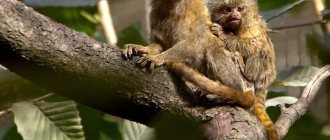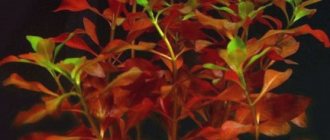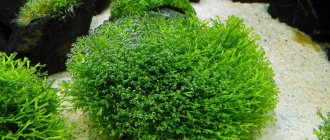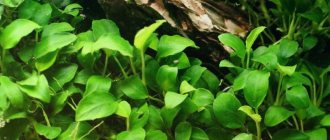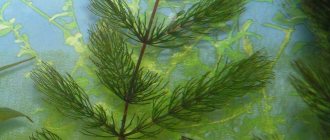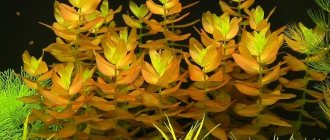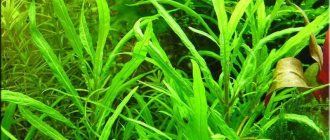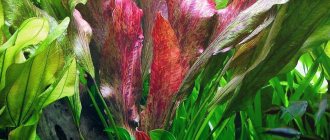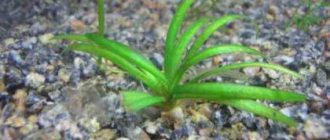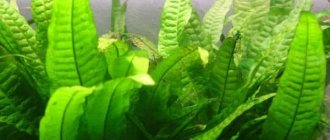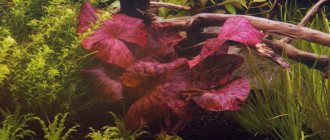In this situation, an amazingly beautiful plant, Rotala Indica, comes to the aid of aquarists. The color scheme of its leaves cannot but please the eye: pink, emerald, light green, purple. Such variability of colors is relatively rare in the underwater world.
In addition to its excellent decorative qualities, it is unpretentious in care, quickly takes root in the herbal garden and is affordable. This delicate plant forms dense clumps that look charming in any water tank.
Getting to know the plant
The general public is more familiar with Indica Rotala as an aquarium plant than as a weed in rice fields. The grass originated in the tropical reservoirs of Southeast Asia. Grows in shallow waters in weakly flowing water. Clinging to the bottom of the reservoir with a creeping rhizome, it forms dense purple thickets with almost half a meter of erect stems. Small (1 - 2.5 mm) succulent leaves add color to the plant. Shoots above the surface bloom.
In the water column, the leaves are ovoid and elongated; they are arranged oppositely and loosely on the stem. Above the surface they are rounded, thickened, and acquire a characteristic glossy sheen. Pink flowers appear in the leaf axils.
The genus name rotalis is translated from Latin as “having wheels.” It is not in vain that Indica Rotala got its name - it now travels around the world, although the official reason for naming the plant was the whorled arrangement of the leaves.
As an introduced species, Indica Rotala successfully infests the rice plantations of Congo, Italy, and Portugal. It grows in the tropical climate of California and Louisiana. It is also found in the wetlands of subtropical Transcaucasia.
A part of the huge genus of plants Rotala, the aquatic grass Rotala indica, was studied and systematized by the German botanist K.L. Wildenov at the beginning of the 19th century:
| Chapter | Name |
| Kingdom | Plants |
| Family | Derbennikovye |
| Department | Angiosperms |
| Class | Rozoids |
| Squad | Myrtaceae |
| Genus | Rotala |
Since 1960, there has been confusion among aquarists regarding the names of the species. Rotala rotulifolia was often called Indian. They got the true plant in 2009 under the name Ammania “Bonsai”. The error was corrected in 2013.
Features of an aquarium plant
The artificial habitat leaves its mark, giving the plant its own flavor. The bush grows quickly, within a month, but is low to 25 cm. The diameter of the juicy round stem is up to 2 mm. Ideal for small aquariums. New shoots emerge from numerous buds of the rhizome, forming a lush tussock. In the water column, the stems are elongated and pressed tightly against each other; on the water surface they form a rounded shape.
Weak roots and a minimum of absorbed nutrition allow the use of Indian Rotala both rooted and floating.
Rotala does not bloom under water; its decorative appearance is represented by bright leaves. Their color scheme depends on the saturation of light rays: light green, emerald, red-brown, with a pink or purple tint. The expressiveness of grass is indispensable in creating fantastic aquarium compositions.
Mr. Tail recommends: varieties
30 species of rotala have been recorded. The most famous are the following.
| View | Peculiarities |
| Rotala rotundifolia (round-leaved) | Lives in Southeast Asia. The length of the stems is 30 cm. The width of the bush reaches 18 cm. Comfortable ambient temperature +18…+30 °C. A good option for landscaping an aquarium. |
| Rotala Wallichil | The size of the species is similar to other varieties of the plant. Only good care will ensure the pink color of Rotala's thin leaves. Fish owners love it for its unpretentiousness. |
| Rotala macrandra | The large-stamened plant comes from India. Reaches a height of 25-30 cm and a width of 6 cm. The oval leaves are thin and pink and look great in any aquarium. |
Indica Rotala - jackpot for the aquarium
Indica is valued not only for its exotic hydrophyte, but also for its ability to maintain the biological balance of the biosystem environment. In the Rotala aquarium, Indian serves as a kind of filter, participating in metabolic processes:
- absorbs carbon dioxide;
- produces oxygen;
- neutralizes excess nitrates and phosphates.
The grass is considered a “litmus test”, reacting with the color of its leaves to any changes in water balance.
11:27
Signs of a lack of Microelements in the Aquarium. Clearly! Filamentum on Moss Xenococus on Anubias
07:16
Aquarium plants. Rotala macrandra and fertilizer dosages for it.
04:57
Growing rotal. Rotala Blood red and Rotala macrandra sp. Florida.
Fish like to eat rotala indica. It is better not to use it with those digging the bottom, because, raised from the bottom, the suspension will destroy the plant.
general description
Indian rotala or, as it is also called, round-leaved rotala, is an ornamental plant native to the tropics. It differs in that it can live not only in aquariums, but also in greenhouses with high humidity. The plant has a long vertical stem, from which green leaves emerge in pairs. Depending on the species, the number of leaves may vary. Interestingly, in good lighting, their lower part takes on a red tint.
Ammania bonsai can be placed simply in water or planted in the soil of an aquarium. According to the experience of aquarists, when rooted in the ground, it grows faster and looks better. The advantages of this plant include unpretentiousness and good survival rate. Indian rotala grows well in almost any conditions. However, it almost always blooms only on land.
Variations of the species
There are few varieties of Indian Rotala; subspecies differ in the number of leaf blades in the whorl. There are 2, 3 and 4 leaf specimens. The 2-sheet form remains more aesthetically pleasing for a long time. The leaves of this hybrid are large, 2 cm long and about 5 cm wide.
In other variants, the leaves are narrower; due to thickening, the upper leaves shade the lower ones. From lack of light they fall off, leaving the stem bare. There is a way out: place the grass in the background, covering the bare stems with large-leaf plants.
How to properly care for a plant
To feed rotala, you can use mineral fertilizers in small quantities. Some varieties are demanding of iron-containing fertilizers, which are necessary for color intensity. To prevent these algae from growing too much and filling the entire aquarium, you need to periodically thin out and trim them.
Important! These aquatic plants do not like external interference as they are quite fragile. In order not to damage the leaves and stems, you should not install aerators and filters near them, and also do not touch them with your hands. The most sensitive to such interference are the large-stamened rotala and the Wallich rotala.
Rotala grows quickly, gradually exposing part of the stem at the bottom, so as necessary, plants need to be updated and replaced with young specimens.
Conditions of detention
Even a novice aquarist can grow an unassuming hydrophyte. If the fish are comfortable in the aquarium, then the grass feels great. Given the origin of the plant, it is preferable to keep Indica Rotala in tropical conditions.
Water environment
In nature, Indica grows in slightly flowing water, so it is enough to replace a quarter of the volume once a week. Weed is more demanding in terms of acidity and hardness. It feels better in neutral or slightly acidic water, pH in the range of 5 – 7, GH 2 – 12°.
No less picky about temperature, yet it is a tropical crop. Maintaining parameters of +24 – 28°C will have a positive effect on her appearance and health. No additional supply of carbon dioxide is required; its concentration in water is sufficient.
Priming
Indica rooted Rotala looks more aesthetically pleasing. Although it is not picky about the composition of the substrate, it is nice if it is neutral and supplemented with a small amount:
- clay;
- peat;
- silt.
Together with pebbles, the thickness of the layer is 5 cm. The presence of silty compounds will provide Indica with long-term nutrition and additional feeding will not be needed.
You can buy soil for aquarium plants ready-made or make it yourself.
Lighting
The saturation of the light rays affects the aesthetics of Rotala. In shaded conditions, the leaves turn pale and the stem becomes elongated, so additional lighting is used. Light the aquarium for up to half a day. Optimal light intensity is 80 – 100 Lm/l. If the plant is comfortable, it actively begins to grow, and the leaves turn red.
Indica Rotala tolerates short-term shading, but excess light radiation turns out to be destructive and threatens the appearance of algae that are dangerous for the grass.
Diseases
Changes in leaf color and wilted appearance indicate a violation of the following rules:
- untimely fluid change;
- excessive lighting;
- proximity to blue-green algae;
- placing filter or aerator tubes next to the bushes;
- working with the plant without gloves or tweezers;
- prolonged exposure of the roots of the seedling when transplanting outdoors;
- soil quality.
If the grass has died, it is necessary to promptly remove the rotten stems.
Indica will be healthy if: it lives in a clean aquarium without “bearded algae” and the like, in renewed water and high-quality soil, it has enough nutrition, the duration and brightness of lighting is maintained at normal levels.
Planting, care, reproduction
To get a new Indian Rotala plant, it is enough to cut cuttings with 3–4 internodes and let them float freely on the surface of the water. When roots appear, immediately plant the cutting vertically in the ground, otherwise Indica will stunt growth.
08:03
Added to the herbalist Rotala H»Ra
10:51
ROTALA INDICA (ROTALA INDICA)
06:32
Indian rotala haircut (rotala indica)
Planting with several stems looks more impressive than a single plant. Even from one cutting, a full-fledged bush is obtained by pinching the top of the shoot. The grass grows quickly; within a month a fluffy tussock appears. Periodic thinning will protect against shade and leaf loss. Once a month, it is enough to cut out the bare stems and leave suitable cuttings for seedlings.
Planting and propagation
Experienced aquarists advise planting young shoots of Rotala in small “beds”, up to 20 stems. Its location along the back wall will allow it to be beautifully illuminated and will not interfere with watching the fish. Some plants can be left floating on the surface.
Rotala can be propagated by cuttings or root shoots. You can do this in a greenhouse:
- Prepare the cuttings.
- Plant planting material in watered soil.
- Wait for rooting.
- Transplant into a prepared pond.
After adaptation, if the conditions are met, the cutting will begin to develop and throw out new shoots.
Planting material can be left floating in the aquarium. In a few days, it will develop thin roots 0.5-1 cm. Rotala has a creeping root system, so it should not be planted deep.
Reviews and advice for beginners
Although Indica Rotala appeared relatively recently among aquarists, it has already caused a lot of controversy. Some consider it a “plant for the lazy,” others consider it a finicky herb. However, their discussions provide invaluable assistance to beginners. Here's what they recommend:
- Large herbal plants with a variety of species require fertilizers, and Indica Rotala is sensitive to copper, boron, and iron content. Before feeding, you need to remove the bushes from the aquarium.
- Choose artificial light in the red-orange range.
- Shoots that escape the water column begin to bloom, while those that have faded lose their decorative effect. They should be pinched at the surface of the water.
- If the Indica leaves appear larger and brighter near the water surface than at the bottom, CO2 should be added.
Beginners need to be careful and careful when using fertilizers - Indica Rotala is very sensitive to excess micro and macroelements.
The unassuming universal hydrophyte Indica Rotala is increasingly interested in landscapers. Not only the decorative and cleansing functions of the grass attract their attention, but also the affordability of the price.
Treatment and prevention of diseases
The first time after transplantation is considered a dangerous moment for the development of diseases. From greenhouse conditions, the plant is transported to an unusual environment, experiencing stress. It is important at these moments to provide the rotala with normal conditions. In addition, ailments are provoked by water, which does not provide the necessary microelements and poor-quality soil.
The first signs of disease appear immediately, the plant changes color (turns pale) and becomes lethargic. Infected and rotten parts are removed as soon as possible using tweezers.
To protect against algae, it is recommended to regularly clean the aquarium and refresh the water . In addition to them, roots exposed to the air (during transplantation) and careless touching with fingers are dangerous.
With proper maintenance, the plant pleases the eye all year round, without going into a dormant period. Decorating an aquarium is easy if you provide timely care for the plants living in it.
Advantages
Rotala Hra is one of the most unpretentious plants. Scientists attribute this to the laboratory origin of the tissue.
In addition to ease of care, there are other advantages:
- unusual color with proper care;
- high productivity;
- easy pruning;
- neat appearance;
- absence of pests on fabrics;
- low susceptibility to algae accumulation on leaves.
In the case of Rotala, the possibility of accidentally transporting pests or algae spores is minimized. This means that neighboring bushes will not be harmed when the plant is transferred to the aquarium.
Similar plant forms
The Rotala family includes several plant species:
Rotala Green
Most similar to Rotala Hra. The plants have an identical growth pattern and elongated leaf shape. The main difference is the color. The Green form has exclusively light green leaves.
Rotala rotundifolia Colorata
Often confused with Khra bushes. However, the species differ in leaf shape and shade. The former have a horizontal growth pattern and a richer orange or red color.
How to properly keep rotala in an aquarium
Most rotals are very picky about their living conditions.
The necessary conditions
In order for rotals to show themselves in all their glory, they should create a certain environment.
Did you know? Rotals look most beautiful in group plantings.
When decorating an aquarium, it is recommended to place them closer to the walls. Since they are often used to decorate background or middle backgrounds, backlighting is used for these light-loving plants.
Temperature
When keeping rotala, it is necessary to ensure a temperature regime of the aquatic environment of at least +24 °C. Lower temperatures lead to slower plant growth.
Lighting
Rotala prefers moderately bright lighting. With a lack of sunlight, it loses its beautiful appearance - it stretches out and turns pale. The plant normally withstands only slight shade. In favorable light conditions, rotala leaves have pinkish or golden hues.
Daylight hours should be approximately 12 hours. In winter, when daylight is short, it is necessary to provide artificial lighting using a fluorescent lamp or incandescent lamp, which is placed next to the aquarium.
You can also decorate your aquarium with the help of plants such as cabomba, salvinia, pistia floating, glossostigma, nymphoides, elodea, echinodorus.
Water requirements
The water in the aquarium must be soft or slightly hard (gH no more than 6). If the hardness is exceeded to 12, the rotala may wither. The required acidity of the aquatic environment must be neutral or low acidity.
Editorial: Cyperus Helfera
This aquatic plant does not tolerate an alkaline environment well. Rotala loves clean water, so changes should be done regularly (20–25% of the total volume of water), filtration and aeration should be ensured. Dirty water has an adverse effect on the development and appearance of the plant.
It is necessary to ensure that algae does not appear in the water - they spoil this plant. You should also monitor the water level: it should be sufficient for the rotala to be completely submerged.
Priming
Rotala is completely undemanding when it comes to soil selection. Moreover, having a weak root system, it can develop in the water column. But it is worth considering that rotala planted in the ground has a more beautiful appearance, since it receives more nutrients from the soil than simply floating in the water.
Pebbles with the addition of peat or clay are excellent for soil. For a weak root system of the plant, about 3 cm of soil in the aquarium is sufficient.
Benefits for the aquarium
This is a graceful, actively growing herb. It looks impressive as a plant on its own, emphasizing the structural depth of the background of the aqua zone, and can be used to create aesthetically attractive underwater compositions.
From the editor: Apistogramma electric blue neon
Rotala affects the hydrochemical characteristics of the aquatic environment:
- absorbs nitrogenous and other compounds;
- saturates water with oxygen;
- becomes a haven for bacterial flora, which is a natural aquarium filter.
It creates favorable conditions for the life of fish and other inhabitants of the artificial biocenosis. Fry and adults can hide in the thickets; the foliage serves as an additional source of food for some of them.
Appearance and distribution
Rotala hra is a relatively young breeding plant. This variety is native to the central regions of Vietnam. It was first bred in the province of Gia Lai, so the prefix Gia Lai is sometimes added to the Latin name.
Thanks to its ease of care and rapid growth, Rotala is in demand all over the world. It is suitable for distribution in any region. It can be cultivated even in compact aquariums.

